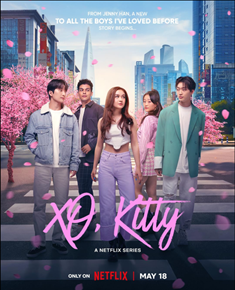[한류] Reverse-Hybridity and its impacts, Misperception on Korea and Asian Stereotypes : A Case Study of the Netflix Series XO Kitty (서구 제작 한국 관련 콘텐츠)
Their stereotypes are ethnic biases created by American-centric perception, rooted in the concept of Orientalism, referring to the Western portrayal of Asian cultures through a lens of presumed Western superiority.
Author: Lee Jihyun (Master's course at Seoul National University)
1. Introduction
Hybridity has been regarded as one of the main sources of the Korean Wave’s worldwide popularity. It truly plays a pivotal role in disseminating Korean culture by lowering the cultural hurdle for non-Koreans who have never experienced the exotic culture.
With the growing awareness of Korea and Hallyu phenomenon, there has been an increasing number of Korean-related contents produced outside Korea by non-Korean producers, such as "To All the Boys I've Loved Before" and "XO Kitty" (a spinoff of "To All The Boys I’ve Loved Before") in the United States, "Eye Love You" in Japan. This research calls such phenomenon ‘reverse-hybridity’, derived from Homi K. Bhabha’s notion of hybridity: A mixture of elements of producing countries, which have been regarded as ‘superior’ and Korea, ‘inferior’. As more ‘reversely hybridized’ contents are consistently being produced, it becomes crucial to estimate these effects and to critically view whether such examples can be regarded as Hallyu contents.
Therefore, this research conducted a case study of the reversely hybridized content called "XO Kitty", a Netflix series directed by a Korean-American producer in the United States. With the analysis, this research aims to criticize ill-depiction and inaccurate illustration of Korean culture and lifestyle in the reversely hybridized content, which eventually tends to instigate misperceptions on Korea, and even Asian stereotypes that are stemmed from the American perspectives of Asian countries.
2. Research Background
Hybridity and Reverse-hybridity(혼종성과 역혼종성)
This research borrowed a notion of hybridity, which was first introduced in Homi K. Bhabha’s book "The Location of Culture". According to Bhabha, Hybridity refers to a mixture of cultures of both the colonizing and colonized countries. In other words, hybridity is ‘the third space’ where cultures of the two groups-the object and the subject-continuously intermingle, eventually creating the ‘third space’. In the process of hybridity, the cultures of objects are planted above the traditional cultures of subjects and finally a new culture is created.
Based on the definition by Bhabha, the term ‘reverse-hybridity’ in this research refers to a cultural mixture of both objects and subjects, but the cultures of subjects are conversely planted above the cultures of objects. Applying the term to the Hallyu phenomenon, the United States has historically been regarded as the cultural colonizer of South Korea, which has heavily relied on American culture and technology. Considering Korea’s geopolitical and diplomatic history, it is undeniable that South Korea has been greatly influenced by the United States. For instance, according to Kyung Hyun Kim, during the period of Korean War in the 1950s and afterwards, modern Korean pop culture could not help but be shaped by the United States and it finally enabled Korean culture to evolve into what we now call Hallyu. In this sense, Korean culture including popular culture has been developed through hybridity with American culture. However, thanks to the growing popularity of Korean culture around the globe, the United States has begun to conversely hybridize its culture to Korean culture. Here, the research defines such phenomenon ‘reverse-hybridity’.
진정한 한류 콘텐츠의 조건
What are Hallyu contents?
Basically, in a lexical term, Hallyu contents can be understood as a mixture of elements of both colonizing countries such as the United States and Korea, thus; they gained global popularity and helped raise an awareness of Korean culture.
However, it is important to note that the contents which should be regarded as a Hallyu content should not lose its Korean-ness amid hybridization. Yuan Yin’s analysis of the global success of "Squid Game" highlighted the point. According to Yin, elements of Korean culture in "Squid Game", such as traditional children’s games and retro street foods reinforce rather than disrupt the logic of cultural homogenization. It was the co-existence of the Netflix’s ‘Americanized globalization’ and Korean cultural elements-such as daily life and traditional practices-that led to an enormous success of "Squid Game". In other words, by utilizing Netflix as a platform to disseminate contents all over the world, well-interpreted and well-depicted Korean culture sparked foreign audiences’ curiosity and interest in Korea. As Yin highlighted, successful hybridity in contents means that it should not lose its unique cultural identity while the globalized capital and technology intervene. In conclusion, Hallyu contents, which are basically born from the hybridity between local Korean-ness and foreign-ness, must preserve the uniquness of Korea, regardless of who creates the contents. Cultural identity should not be misrepresented or distorted.
왜곡된 한국문화
Asian Stereotypes and Misperceptions on Korea
Aligning with the concept of hybridity discussed above, this research aims to figure out whether misperceptions on Korea or even Asian Stereotypes are instigated by the reversely hybridized contents, by examining a content made outside Korea that deals with Korean-ness.
Because the reversely hybridized contents are created by non-Korean producers, Korean culture and lifestyle are likely to be illustrated based on the image and stereotype they have. This is also why contents that depict Asian culture but are produced by Western producers have been controversial that the depiction of Asian culture is biased. Their stereotypes are ethnic biases created by American-centric perception, rooted in the concept of Orientalism, referring to the Western portrayal of Asian cultures through a lens of presumed Western superiority. More specifically, Orientalism is a prejudice of the Westerners toward Asian cultures: Asian countries are inferior to Western countries-exotic, feminine, poor and uneducated-and this deep-rooted prejudice has shaped the way Asians have been depicted in American mass media for centuries.
Therefore, by synthesizing the theories above-reverse-hybridity, the definition of Hallyu contents and Asian stereotypes-this research investigates whether the reversely hybridized contents, which are created by Western producers, also perpetuate Asian stereotypes and misperceptions on Korea. Specifically, it examines whether such contents can be considered a Hallyu content through a case study discussed below.
3. Research and Analysis
Methodology
Unlike most of the contents that have analyzed Korean contents created by Korean producers, this research delves into the series that added Korean factors to non-Korean backgrounds, here, the original American-produced content called "XO Kitty".
To figure out whether the reversely hybridized contents can be regarded as Hallyu contents and therefore, don’t eventually lead to misperceptions on Korea and Asian stereotypes or not, this research collected two main data: 1) The most-watched weekly rankings both in Korea and the United States from tudum, a website operated by Netflix to deliver news, announcements and promotional content regarding Netflix contents, and 2) reactions of both Koreans and Americans on the series from Watchapedia, Google reviews, Naver blogs and YouTube.

사례 분석
A Case Study: The Netflix Series "XO Kitty"
"XO Kitty" is an American romantic comedy drama produced by a Korean American author, Jenny Han, in the United States. Being released as a Netflix series in May 2023, this is a spinoff drama of the Netflix romantic comedy movie called "To All the Boys I've Loved Before", in which the main character of the spinoff series’ older sister Lara Jean’s love story is described. This series is about the American-born girl and Lara Jean’s sister, Kitty Song Covey’s school life in Seoul.
However, the main shortcoming of the series was that Korean culture and lifestyle were illustrated based on the images that was impressed by foreigners through unrealistic Korean contents, e.g., Chaebol’s power abuse, or Gapjil(갑질), and a secret of birth. In addition, there are components and scenes that are too intentional to show Korean things which are popular among foreigners, not Koreans, or typical images when foreigners think of Korea. Background music (BGM) such as "Seoul" by BTS or "Pink Venom", intentionally and clumsily described street cultures are the examples. Such scenes might be intended to show Korean elements that Americans fantasized and rooted from the prejudice that the Americans have in their mind.
It is obvious that these Korean‘-ish’ elements are quite crucial to introduce what Koreans’ lifestyle seems like and to carve deeper perception on Korea to foreign audiences. However, some of them were illustrated more in an American way, originated from the American perspectives on Korea. It is, therefore, doubtful if foreign audiences accept an image of Korea in a correct way or rather get Korean stereotypes.
Through the case study, stark differences between the reactions of Korean and American audiences on the series are observed. While Korean audiences focus more on inaccurate and unrealistic portrayal of Korean daily lives and culture, American audiences are attracted to the genre per se and plots, e.g., complex relationships among protagonists. American audiences seem rather flattered that they could experience a new culture through the contents without judges on whether the culture is well illustrated or not and accept the portrayal as it is. This might prove a high rank of the series in the United States, which has never been found in Korea.
This research aims to ask if the reverse-hybridity is the right way of introducing Korea culture to foreign audiences. It is true that the surge of the reversely hybridized contents contributes to the dissemination of Korean culture around the globe, but as the case study of the Netflix series "XO Kitty" has shown that the reversely hybridized contents could rather instigate misperceptions on Korea based on the Asian stereotypes, further discussion and contemplation are needed to seek better ways to preserve uniqueness of one’s culture in the process of hybridity.
참고자료
[1]IMDb. n.d. “Episode Guide.” Accessed Dec 16, 2024. https://www.imdb.com/title/tt14490706/mediaviewer/rm4150210049/?ref_=tt_ov_i.
[2]Jin, Dal Yong. New Korean Wave: transnational cultural power in the age of social media. Chicago: University of Illinois Press, 2016.
[3]Kim, Kyung Hyun, Hegemonic Mimicry: Korean Popular Culture of the Twenty-First Century. NC: Duke University, 2021.
[4]Netflix Tudum. https://www.netflix.com/tudum
[5]Watchapedia. https://pedia.watcha.com/ko-KR/contents/tR5KLop/comments
[6]Yin, Yuan. “Third-Space K-Drama: Netflix, Hallyu, and the Melodramatic Mundane”, International Journal of Communication17 (2023): 6993.
작성자

![[비평] 넷플릭스〈애마〉와 페미니즘 기억 정치학: 젠더, 노동, 재현의 재서사화](https://cdn.media.bluedot.so/bluedot.kwave/2025/11/8rlrua_202511011620.jpg)
![[현장] "배트맨과 이순신을 만난 날..." '뉴욕 코믹콘(COMIC CON)'에서 웹툰의 미래를 보다](https://cdn.media.bluedot.so/bluedot.kwave/2025/10/gs0vr0_202510260949.jpg)